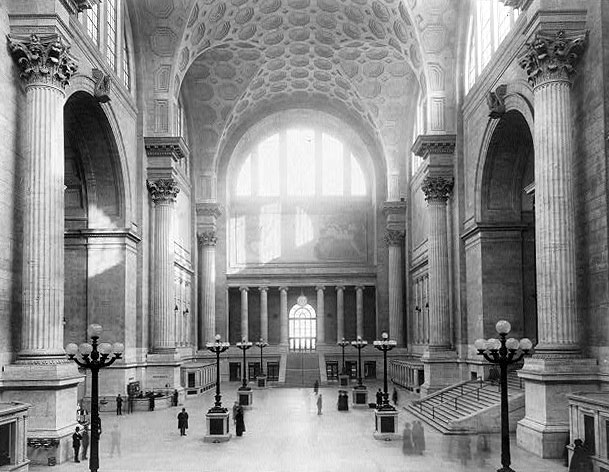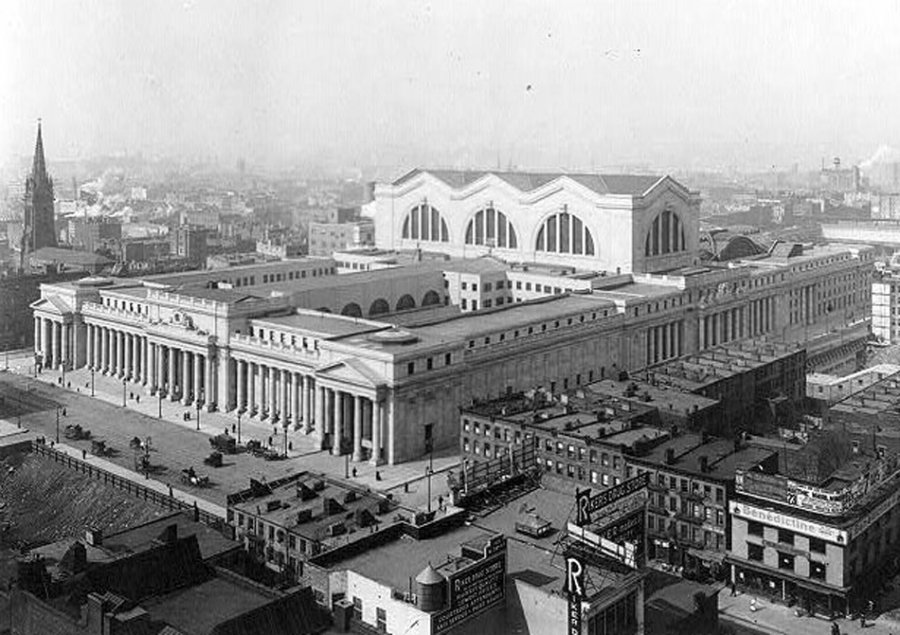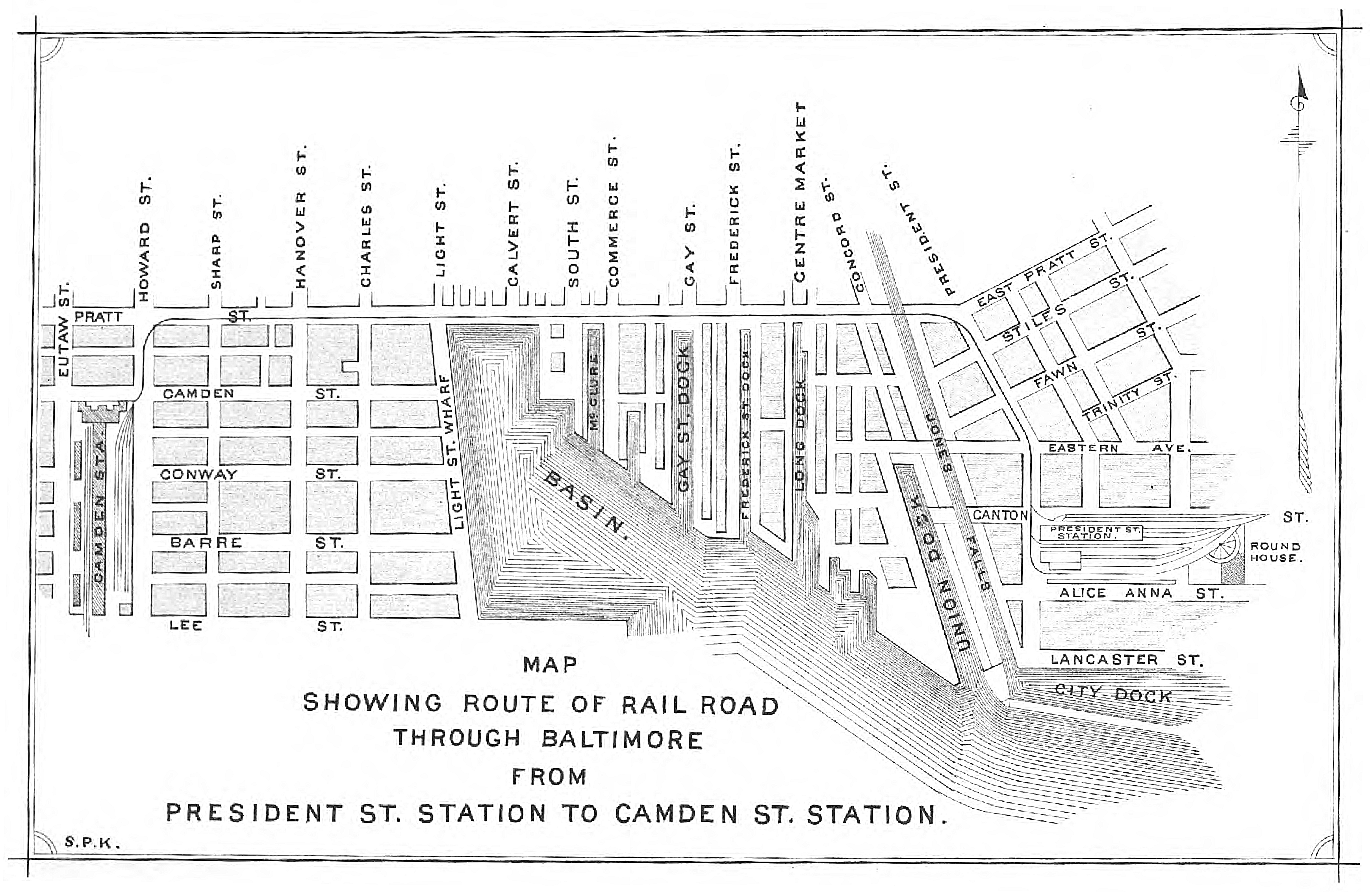|
Samuel Rea
Samuel Rea (September 21, 1855 – March 24, 1929) was an American engineer and the ninth president of the Pennsylvania Railroad, serving from 1913 to 1925. He joined the PRR in 1871, when the railroad had hardly outgrown its 1846 charter to build from Harrisburg to Pittsburgh, and helped it grow to a 12,000-mile (19,000 km) system with access to Manhattan, upstate New York, and New England. Rea was awarded the Franklin Medal in 1926, and was elected as an honorary member of the Institution of Civil Engineers in 1928. Early life and career Samuel Rea was born on September 21, 1855, in Hollidaysburg, Pennsylvania. His parents were James D. Rea and Ruth Blair Moore. His paternal grandfather, General John Rea, was the United States representative from Bedford and Franklin, Pennsylvania, during the terms of Thomas Jefferson and James Madison. Through the marriage of his father's siblings, he was related to the Asa Childs and the Henry Clay Frick families. His father died when ... [...More Info...] [...Related Items...] OR: [Wikipedia] [Google] [Baidu] |
Samuel Rea, Engineer And President Of The Pennsylvania Railroad LCCN91481459 (cropped)
Samuel ''Šəmūʾēl'', Tiberian: ''Šămūʾēl''; ar, شموئيل or صموئيل '; el, Σαμουήλ ''Samouḗl''; la, Samūēl is a figure who, in the narratives of the Hebrew Bible, plays a key role in the transition from the biblical judges to the United Kingdom of Israel under Saul, and again in the monarchy's transition from Saul to David. He is venerated as a prophet in Judaism, Christianity, and Islam. In addition to his role in the Hebrew scriptures, Samuel is mentioned in Jewish rabbinical literature, in the Christian New Testament, and in the second chapter of the Quran (although Islamic texts do not mention him by name). He is also treated in the fifth through seventh books of ''Antiquities of the Jews'', written by the Jewish scholar Josephus in the first century. He is first called "the Seer" in 1 Samuel 9:9. Biblical account Family Samuel's mother was Hannah and his father was Elkanah. Elkanah lived at Ramathaim in the district of Zuph. His geneal ... [...More Info...] [...Related Items...] OR: [Wikipedia] [Google] [Baidu] |
Gustav Lindenthal
Gustav Lindenthal (May 21, 1850 – July 31, 1935) was a civil engineer who designed the Queensboro and Hell Gate bridges in New York City, among other bridges. Lindenthal's work was greatly affected by his pursuit for perfection and his love of art. Having received little formal education and no degree in civil engineering, Lindenthal based his work on his prior experience and techniques used by other engineers of the time. Early life Lindenthal was born in Brünn, Austrian Empire, now Brno, Czech Republic in 1850. Lindenthal began to receive practical training in 1866 when he was employed as a mason and carpenter. At the age of 18, Lindenthal left his family to set out to make a life of his own in Vienna, Austria. Career When he arrived in Vienna he became an assistant in the engineering department for the Empress Elisabeth Railway of Austria. Two years later he joined the Union Construction Company, where he gained experience in building incline planes and railroad ... [...More Info...] [...Related Items...] OR: [Wikipedia] [Google] [Baidu] |
Alexander Cassatt
Alexander Johnston Cassatt (December 8, 1839 – December 28, 1906) was the seventh president of the Pennsylvania Railroad (PRR), serving from June 9, 1899, to December 28, 1906. Family and early life Alexander Cassatt was born on December 8, 1839, in Pittsburgh, Pennsylvania, the eldest of seven children born to Robert Simpson Cassat (later Cassatt), and his wife Katherine Cassatt, the former Katherine Kelso Johnston. The elder Cassatt was a successful stockbroker and land speculator. He was descended from the French Huguenot Jacques Cossart, who came to New Amsterdam in 1662. Alexander's younger sister was the impressionist painter Mary Cassatt. His mother Katherine came from a banking family. She was educated and very well read. It was said that of the seven children Alexander most resembled his mother in "appearance and temperament." In 1856 he entered Rensselaer Polytechnic Institute to study Civil Engineering where his senior thesis was entitled "Review of Pressure T ... [...More Info...] [...Related Items...] OR: [Wikipedia] [Google] [Baidu] |
Panic Of 1893
The Panic of 1893 was an economic depression in the United States that began in 1893 and ended in 1897. It deeply affected every sector of the economy, and produced political upheaval that led to the political realignment of 1896 and the presidency of William McKinley. Causes The Panic of 1893 has been traced to many causes, one of those points to Argentina; investment was encouraged by the Argentine agent bank, Baring Brothers. However, the 1890 wheat crop failure and a failed coup in Buenos Aires ended further investments. In addition, speculations in South African and Australian properties also collapsed. Because European investors were concerned that these problems might spread, they started a run on gold in the U.S. Treasury. Specie was considered more valuable than paper money; when people were uncertain about the future, they hoarded specie and rejected paper notes.Nelson, Scott Reynolds. 2012. A Nation of Deadbeats. New York: Alfred Knopf, p. 189. During the ... [...More Info...] [...Related Items...] OR: [Wikipedia] [Google] [Baidu] |
George Brooke Roberts
George Brooke Roberts (January 15, 1833 – January 30, 1897) was a civil engineer and the fifth president of the Pennsylvania Railroad (1880–96). Early life and education Roberts was born at his family's farm in the Pencoyd region of Bala Cynwyd, Pennsylvania. In 1849, he graduated from Rensselaer Polytechnic Institute and went on to teach there for two years before becoming a rodman for the Pennsylvania Railroad (PRR). Beginning in 1852, he worked for the Philadelphia & Erie Railroad, returning to the PRR in 1862 as assistant to the president, J. Edgar Thomson. Roberts oversaw the construction of bridges and other engineering work, including the Connecting Railway Bridge over Schuylkill River in Philadelphia (attributed to John A. Wilson, 1866–67) that connected PRR's southern and northern lines. He became a PRR vice-president in 1869, and succeeded Thomas A. Scott as PRR president in 1880. He was elected as a member to the American Philosophical Society in 1885. Ca ... [...More Info...] [...Related Items...] OR: [Wikipedia] [Google] [Baidu] |
Electric Locomotive
An electric locomotive is a locomotive powered by electricity from overhead lines, a third rail or on-board energy storage such as a battery or a supercapacitor. Locomotives with on-board fuelled prime movers, such as diesel engines or gas turbines, are classed as diesel-electric or gas turbine-electric and not as electric locomotives, because the electric generator/motor combination serves only as a power transmission system. Electric locomotives benefit from the high efficiency of electric motors, often above 90% (not including the inefficiency of generating the electricity). Additional efficiency can be gained from regenerative braking, which allows kinetic energy to be recovered during braking to put power back on the line. Newer electric locomotives use AC motor-inverter drive systems that provide for regenerative braking. Electric locomotives are quiet compared to diesel locomotives since there is no engine and exhaust noise and less mechanical noise. The lack o ... [...More Info...] [...Related Items...] OR: [Wikipedia] [Google] [Baidu] |
Baltimore Belt Line
The Baltimore Belt Line was constructed by the Baltimore and Ohio Railroad (B&O) in the early 1890s to connect the railroad's newly constructed line to Philadelphia and New York City/Jersey City with the rest of the railroad at Baltimore, Maryland. It included the Howard Street Tunnel, the Mount Royal Station for B&O's '' Royal Blue Line'' passenger trains, and the first mainline railroad electrification in the United States. The line is currently operated by CSX Transportation as part of its Baltimore Terminal Subdivision. Origins The B&O's original connection to New York in Baltimore was through surface street transfers to the old Philadelphia, Wilmington and Baltimore Railroad (PW&B), with passenger / freight cars (also known then as rail carriages) pulled by horses along the east–west running East Pratt Street route, first between the B&O's old Pratt Street Depot at Pratt and South Charles Streets, then later using the new terminal and B.& O.'s general headquarters of Ca ... [...More Info...] [...Related Items...] OR: [Wikipedia] [Google] [Baidu] |
Maryland Central Railroad
The Maryland Central Railroad (MCRR) was a 19th-century narrow gauge railroad in Maryland, with a small track section in Pennsylvania. It operated freight and passenger trains between Baltimore and Delta, Pennsylvania. History The Maryland Central was chartered by the Maryland General Assembly in 1867 to build a railroad from Baltimore to Philadelphia. It was not successful at raising sufficient funds for construction through the 1870s. (A competing railroad, the Philadelphia, Wilmington and Baltimore, had the same objective and had completed a bridge over the Susquehanna River in 1866.) Another company, the Baltimore and Delta Railway began building a gauge line in 1878 to reach slate quarries in Delta, and to interchange with the Peach Bottom Railway. The southern portions of the Baltimore & Delta opened in 1882, but the company needed additional funds for completion. It merged with the Maryland Central in August 1882. MCRR continued the construction northward and reached Be ... [...More Info...] [...Related Items...] OR: [Wikipedia] [Google] [Baidu] |
Charles F
Charles is a masculine given name predominantly found in English and French speaking countries. It is from the French form ''Charles'' of the Proto-Germanic name (in runic alphabet) or ''*karilaz'' (in Latin alphabet), whose meaning was "free man". The Old English descendant of this word was '' Ċearl'' or ''Ċeorl'', as the name of King Cearl of Mercia, that disappeared after the Norman conquest of England. The name was notably borne by Charlemagne (Charles the Great), and was at the time Latinized as ''Karolus'' (as in ''Vita Karoli Magni''), later also as '' Carolus''. Some Germanic languages, for example Dutch and German, have retained the word in two separate senses. In the particular case of Dutch, ''Karel'' refers to the given name, whereas the noun ''kerel'' means "a bloke, fellow, man". Etymology The name's etymology is a Common Germanic noun ''*karilaz'' meaning "free man", which survives in English as churl (< Old English ''ċeorl''), which developed its ... [...More Info...] [...Related Items...] OR: [Wikipedia] [Google] [Baidu] |
Baltimore And Ohio Railroad
The Baltimore and Ohio Railroad was the first common carrier railroad and the oldest railroad in the United States, with its first section opening in 1830. Merchants from Baltimore, which had benefited to some extent from the construction of the National Road early in the century, wanted to do business with settlers crossing the Appalachian Mountains. The railroad faced competition from several existing and proposed enterprises, including the Albany-Schenectady Turnpike, built in 1797, the Erie Canal, which opened in 1825, and the Chesapeake and Ohio Canal. At first, the B&O was located entirely in the state of Maryland; its original line extending from the port of Baltimore west to Sandy Hook, Maryland, opened in 1834. There it connected with Harper's Ferry, first by boat, then by the Wager Bridge, across the Potomac River into Virginia, and also with the navigable Shenandoah River. Because of competition with the C&O Canal for trade with coal fields in western Maryland ... [...More Info...] [...Related Items...] OR: [Wikipedia] [Google] [Baidu] |
New York Stock Exchange
The New York Stock Exchange (NYSE, nicknamed "The Big Board") is an American stock exchange in the Financial District of Lower Manhattan in New York City. It is by far the world's largest stock exchange by market capitalization of its listed companies at US$30.1 trillion as of February 2018. The average daily trading value was approximately 169 billion in 2013. The NYSE trading floor is at the New York Stock Exchange Building on 11 Wall Street and 18 Broad Street and is a National Historic Landmark. An additional trading room, at 30 Broad Street, was closed in February 2007. The NYSE is owned by Intercontinental Exchange, an American holding company that it also lists (). Previously, it was part of NYSE Euronext (NYX), which was formed by the NYSE's 2007 merger with Euronext. History The earliest recorded organization of securities trading in New York among brokers directly dealing with each other can be traced to the Buttonwood Agreement. Previously, sec ... [...More Info...] [...Related Items...] OR: [Wikipedia] [Google] [Baidu] |
Pittsburgh
Pittsburgh ( ) is a city in the Commonwealth of Pennsylvania, United States, and the county seat of Allegheny County. It is the most populous city in both Allegheny County and Western Pennsylvania, the second-most populous city in Pennsylvania behind Philadelphia, and the 68th-largest city in the U.S. with a population of 302,971 as of the 2020 census. The city anchors the Pittsburgh metropolitan area of Western Pennsylvania; its population of 2.37 million is the largest in both the Ohio Valley and Appalachia, the second-largest in Pennsylvania, and the 27th-largest in the U.S. It is the principal city of the greater Pittsburgh–New Castle–Weirton combined statistical area that extends into Ohio and West Virginia. Pittsburgh is located in southwest Pennsylvania at the confluence of the Allegheny River and the Monongahela River, which combine to form the Ohio River. Pittsburgh is known both as "the Steel City" for its more than 300 steel-related businesses and as the ... [...More Info...] [...Related Items...] OR: [Wikipedia] [Google] [Baidu] |








_train.jpg)